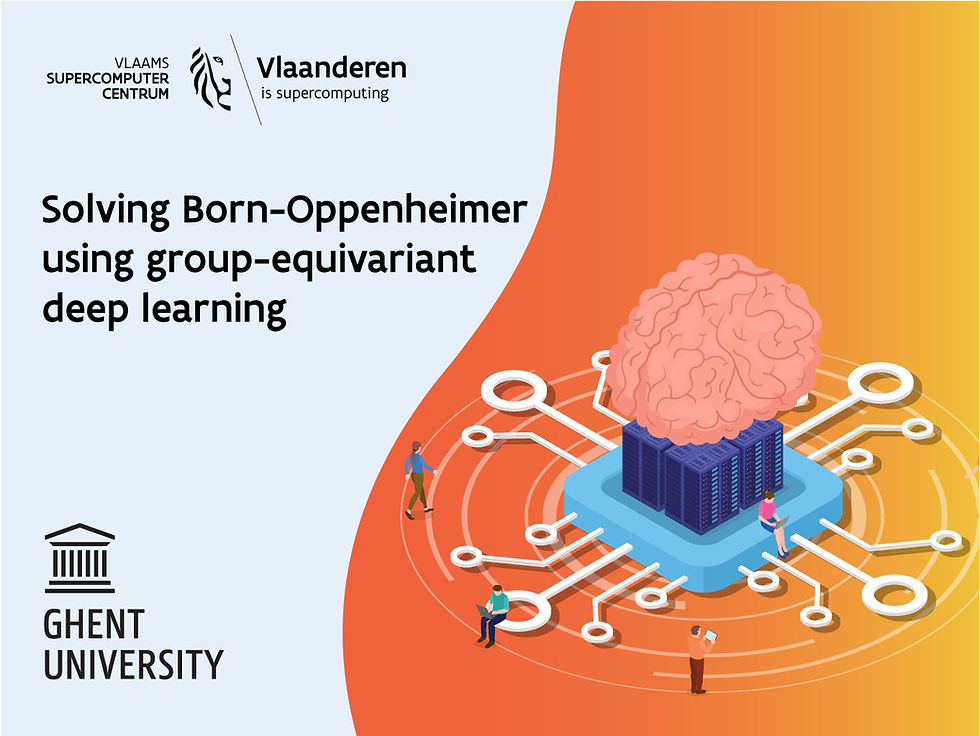Solving Born-Oppenheimer using group-equivariant deep learning
- Rafal Tekreeti
- Mar 9, 2023
- 3 min read
By Sander Vandenhaute, Mieke De Schepper, Veronique Van Speybroeck

Quantum mechanics allows us to understand and predict the properties of complex molecules and materials. A key simplification that is made in order to be able to solve the quantum mechanical equations for realistic systems of practical importance is the Born-Oppenheimer approximation. Effectively, it implies that the answer to questions such as “what is the total reaction rate of this chemical process” to “what is the maximum pressure this material can sustain” and even “how much hydrogen gas can we store in this porous framework” may be found without having to solve the nigh-unsolvable Schrödinger’s equation – the central differential equation in quantum mechanics. No, for many systems of practical importance, Born and Oppenheimer stated that the individual atoms may actually be considered as simple, classical point-like particles which behave according to Newton’s equation of motion: F = ma.

Figure 1. Atomic structures of two prototypical metal-organic frameworks; the class of nanoporous materials that were studied in this work. Important macroscopic properties are e.g. the maximum absorbed capacity of hydrogen gas or the threshold pressure which triggers the closing of the winerack structure on the right. The latter property is explicitly computed in this work and shows excellent agreement with the experimental value. Image reproduced from [1]
For this approximation to make sense, the effective force F needs to capture most of the quantum tomfoolery of the system, and this is absolutely nontrivial. The more ‘complete’ a specific force approximation is, the more expensive it is to compute and the more impractical it becomes when using it for real systems. To overcome this computational challenge, researchers began to develop machine learning models which are able to predict these forces based on the positions of each of the atoms. Essentially, this allows us to bypass the computationally expensive quantum mechanical calculations and reduce the financial and environmental cost of computational research on molecules and materials by orders of magnitude. At the moment, the state of the art in such force prediction models — also referred to as machine learning (interatomic) potentials – is achieved by equivariant neural networks. These models are specifically designed to incorporate the intrinsic physical symmetries that are present in an arrangement of atoms – rotational, translational, and even permutation invariance. By doing so, they achieve exceptional levels of accuracy and are now used in a myriad of applications.
"Psiflow allows us to perform large amounts of quantum mechanical calculations on CPUs and model training on GPUs in a single workflow. [...] specific configurations for VSC systems are included by default."
However, these machine learning potentials are only as accurate as the dataset of reference calculations they were trained on – and generating high-quality datasets has turned out to be nontrivial in many cases. In particular, a reliable parameterization of these models requires a training dataset of QM reference calculations that covers all the relevant atomic configurations of interest. This is often very challenging because the intrinsic time scale in most of the relevant processes in biology or chemistry is much larger than what is achievable using traditional simulation methods, and as a result, it is very expensive and sometimes even impossible to generate sufficient training data in the first place.
Enter incremental learning; a new methodology that was developed at the Center for Molecular Modeling, in which the machine learning potential is trained on the fly while new atomic configurations are continuously generated and added to the training set. A key component is the use of enhanced sampling to accelerate the simulation dynamics, which allows it to include more diverse samples in the training set, leading to more accurate estimates of the interatomic force F and, ultimately, more accurate predictions of physical properties (Figure 2). The algorithm is implemented in psiflow, a modular online learning library for interatomic potentials that is scalable towards hundreds or even thousands of compute nodes. It is configurable on a wide range of high-performance computing platforms, and specific configurations for VSC systems are included by default. Psiflow allows us to perform large amounts of quantum mechanical calculations on CPUs and model training on GPUs in a single workflow. For more information, check out our open-access article in npj Computational Materials.

Figure 2. Explicit simulation of the structural transition of the framework shown in Figure 1 (right). We were able to train our interaction potential with negligible amounts of compute resources while predicting a threshold transition pressure of 18 – 20 MPa, which is in very good agreement with experimental data (and a drastic improvement with respect to previous computational estimates). Image reproduced from [1].
[1] Sander Vandenhaute, Maarten Cools-Ceuppens, Simon DeKeyser, Toon Verstraelen, Veronique Van Speybroeck, npj Computational Materials, 9, 19 (2023).
Read the full publication in the Nature Portfolio here.
